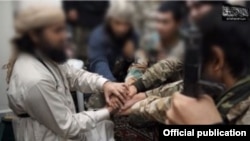KABUL, The Afghan Taliban are apparently in a catch-22 over the emergence and rise of the Islamic State (IS) in Afghanistan.
The hard-line insurgent movement sees losing its fighters and commanders to IS as a strategic threat to its very survival in the long term.
Former Taliban Foreign Minister Wakil Ahmed Muttawakil thinks the lure of IS cash and its zeal for seemingly unending violence has already attracted many Taliban commanders.
Muttawakil says insurgent leaders such as Sayed Emarati and Mawalwi Najib in the southeastern Logar and Wardak provinces and Mawlawi Qahar from Kunar Province were recently lured by IS money.
He says the three joined IS after the Taliban warned them for their alleged involvement in criminal acts such as extortion and kidnapping.
Such defections are the core of the evolving competition between the two militant groups.
To most outsiders, the Taliban and IS might appear similar. After all, both are bent on enforcing their version of Islam through the barrel of a gun. But there are significant differences.
IS follows Salafi Tukfirism, an extreme form of the Sunni Wahhabism, which is the state religion in Saudi Arabia and neighboring Gulf states. The Taliban, however, follow Deobandism, a puritanical branch of Sunni Islam in South Asia.
While IS, also known as ISIS or ISIL, wants to establish a global Islamic Caliphate beyond the vast swathes of Syria and Iraq it now controls, the Taliban’s ambitions are limited to Afghanistan and focused on recreating the Emirate it ran there before the U.S.-led military operation forced its demise in late 2001.
Despite such differences, the massive IS financial resources and appeal of its ascendency make many Afghan Taliban fighters vulnerable to recruitment. In addition, after fighting the Afghan and international forces for 13 years, the Afghan Taliban are at a crossroads over whether to make peace or continue fighting.
Some Taliban insiders say agreeing to a peace settlement will cause fractions within the Taliban ranks. Those willing to continue the fight because of ideology or war-profiteering would eventually join IS.
The emergence of IS poses a direct threat to the Afghan Taliban because it is the only international militant group that expects the Taliban to join its global jihad instead of submitting to the Taliban prominence and pledging allegiance to its supreme leader, Mullah Mohammad Omar.
Osama Bin Laden and other senior Al-Qaeda leaders pledged allegiance to Mullah Omar in the 1990s. The Taliban also sheltered a large number of fighters from the Islamic Movement of Uzbekistan (IMU) and were closely allied with some Pakistani Sunni militant factions -- all of whom acknowledged Mullah Omar as their paramount leader and fought for the Taliban.
Even after the demise of the Taliban regime in 2001, the Afghan Taliban expected all Afghan and transnational militant groups to accept its dominance. While fighters from the Tehreek-e Taliban Pakistan (TTP), Al-Qaeda, IMU and Hizb-e Islami operated inside Afghanistan.
They worked under a simple quid pro quo. While they were welcome to fight under the Taliban banners and could shelter in the regions they controlled, they would only pursue their agendas outside Afghanistan and would refrain from controlling Taliban affairs.
IS, however, now expects Mullah Omar and his followers to pledge allegiance to IS leader Abu Bakr al-Baghdadi. IS expects Afghan Taliban leaders to work under its representative in Afghanistan and Pakistan, Hafiz Sayed Khan. He was among the six former TTP commanders who defected to IS in October 2014.
This is a unique and unprecedented challenge to the Afghan Taliban. Insurgent sources say say fighting a rival jihadist network inside their country can undermine their claim to be waging a just struggle against the Kabul administration and its international allies.
To preserve it prominence, however, the Taliban are working overtime to prevent their leaders and fighters from joining IS and are trying to convince those who defected to return.
A Taliban commander in southern Afghanistan who requested anonymity says the Taliban leadership has mobilized a special group called "recruitment commission" to reach out to those who have defected to IS.
He says the threat of IS prompted Taliban leaders to publish Mullah Omar's biography early this month. "It was an effort to remove the confusion over his invisibility and to demonstrate that he still runs the movement because his continued absence is prompting some Taliban to join IS," he said.
IS has already attracted some senior Afghan Taliban figures. Abdul Rauf Khadim, the first leader of IS in Afghanistan, was killed in an airstrike in the southern Helmand Province in February 2015 soon after he was formally appointed as the IS leader in Afghanistan and a deputy to Hafiz Sayed Khan.
Khadim, a former inmate of Guantanamo Bay, was a fluent Arabic speaker and reportedly converted to Takfiri Salfism in the U.S. prison.
Many militants in Afghanistan are now watching whether former top Taliban commander Abdul Qayum Zakir will join IS.
Zakir was sacked by Taliban leaders in April 2014. According to Taliban sources in southern Afghanistan, Khadim had tipped Zakir as his possible successor. The two men were close comrades and were at loggerheads with the Taliban's leaders hiding in Pakistan. If Zakir joins IS, many of his comrades will follow in his footsteps.
Hekmatullah Azamy is a research analyst with the Centre for Conflict and Peace Studies in Kabul, Afghanistan. These views are the author's alone and do not represent those of Radio Free Europe/Radio Liberty.
as/fg






